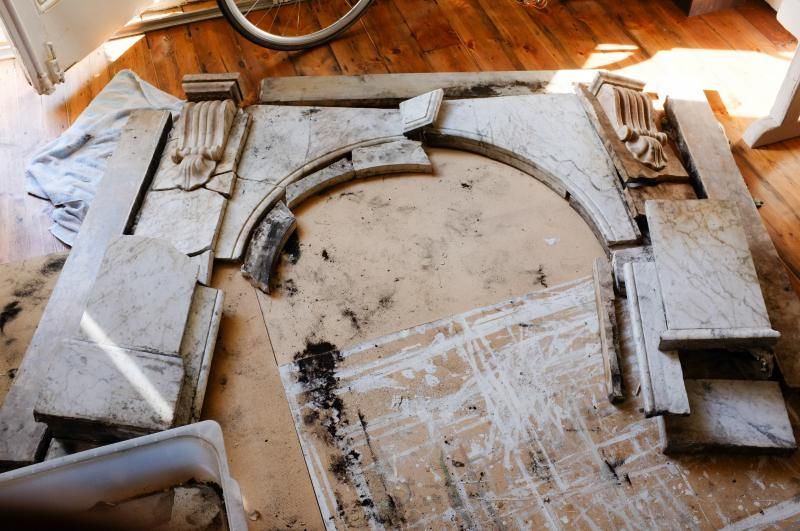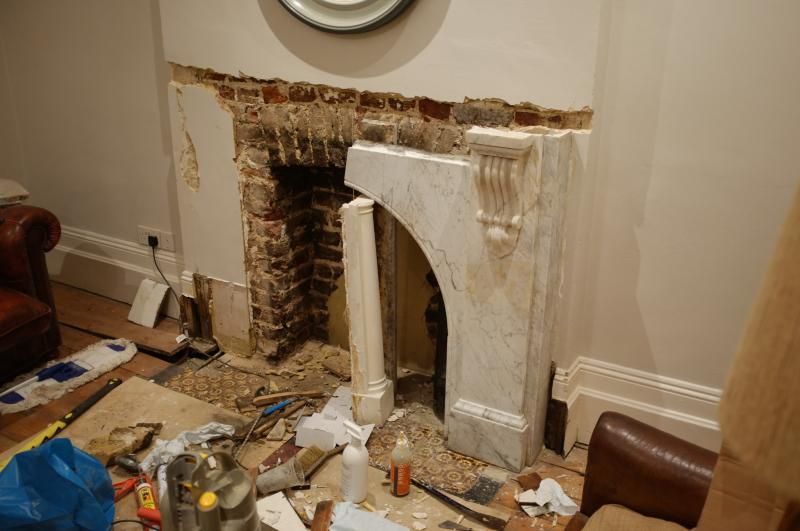-
• #2552
I'd be a bit wary of using those for a shelf it is going to be loaded with books- I'd probably use these as they spread the load across the back of the board:

They are strong, but they require cutting a hole through the plasterboard that's wider thn the screw that then goes through it. The screw-in ones are rated at tens of kgs if I remember correctly, but judgement is obviously required. The best thing is to use a stud finder to erm find a stud and use a really long woodscrew to go clean through the plasterboard and into the wood.
-
• #2553
This is all true. I've put up shelves with them and then loaded them very heavily with no problems, but equally I may have been fine with the screw in fittings.
-
• #2554
The best thing is to use a stud finder to erm find a stud and use a really long woodscrew to go clean through the plasterboard and into the wood.
I think I have an app for that on my phone.
-
• #2555
This is all true. I've put up shelves with them and then loaded them very heavily with no problems, but equally I may have been fine with the screw in fittings.
with what? those plastic / metal rawl plugs?
-
• #2556
I used the butterfly fittings.
As FFM points out you do need to drill a fairly large hole to poke them through, and they may be overkill.
-
• #2557
Been thinking about this phenomenon and I suppose an open fire or properly vented woodburner must draw moist air from the house and away up the chimney presubambly circulating air and essentially dehumidifying the house as well as providing heat. I guess the flipside is that it must be drawing in cold air from somewhere so might it make further reaches of the house draftier.
A stove will draw air in from near the floor where the colder, damper air will be, heat this air and lose it through the chimney, drawing in more damper, cooler air.That's why they'll dry out an inside space as well as giving off loads of heat. Most stoves/burners are 75-85% efficient, whereas an open fire is about 25-30% efficient.
-
• #2558
I used the butterfly fittings.
As FFM points out you do need to drill a fairly large hole to poke them through, and they may be overkill.
gotcha. not overly concerned about the size of the hole (TWSS etc) as it will be covered up by the shelving unit.
to B&Q!
-
• #2559
I think I have an app for that on my phone.
Grindr
-
• #2560
A stove will draw air in from near the floor where the colder, damper air will be, heat this air and lose it through the chimney, drawing in more damper, cooler air.
That's why they'll dry out an inside space as well as giving off loads of heat. Most stoves/burners are 75-85% efficient, whereas an open fire is about 25-30% efficient.
Also, as I understand it., wood burners are designed to do most of their heating with the flue / chimney.
-
• #2561
There's a limit to how much heat you can recover from a flue, you need to keep the exhaust above about 70 degrees C to limit tar condensation.
-
• #2562
I'm not sure I'm referring to heat recovery - just heat radiated from the flue itself.
As opposed to a standard open fire & brick chimney combo.
-
• #2563
Yes I've heard that about flues (been doing lots of reading in preparation for fitting one into the boat). I think* a lot of the efficiency of the stove comes form it being a large lump of cast iron (and fire bricks) that act as a massive heat sink (prior to radiating the heat outwards) and keep the firebox hotter than an open fire which results in better, more complete combustion (as well as cleverly designed insides that give you a secondary combustion of waste gases etc).
*though I am happy to be set straight if this isn't the case.
-
• #2564
I wonder if you wood burning stove experts can suggest a solution to my problem?
I have two fire places downstairs but no chimney stack on the roof - this is because the previous owners extended into the loft and built a dormer extension doing away with the chimney in the process.
How feasible would it be to build a box section in the top floor room/s to contain a flue that exits the roof and extends down into the remaining chimney flue via the first floor and ground floor?
If feasible I could then install a stove into the fire place/s on the ground floor.
Stupidly expensive idea?
I do love a stove!
Thanks
-
• #2565
couldn't you have an 'exposed' flue that would act like a giant radiator?
-
• #2566
n3il - is that directed at me?
Its a nice idea, one I assumed wouldn't work because it'd be too hot - maybe the smoke would have cooled sufficiently by the time it reaches the second floor?
My kids have the upstairs rooms and I don't want anything that'll burn 'em.
Good idea if it'd work!
-
• #2567
Yeah it was, but i have no experience or knowledge about this stuff at all, so ignore me - just a whistful thought.
-
• #2568
A whistful thought is always worth hearing!
-
• #2569
anyone know the best way to affix a shelf to a dry wall without it (the shelf) sagging? Have tried plastic rawl plugs but they don't seem to have sufficient grip and the metal ones are just far too wide for the holes on the shelf brackett. Help me internets!
They're a bit overpriced but some of the Black & Decker piranha ones are quite decent for this.
I can't remember which exactly but there's normally a big display in B&Q or whatever with a whole selection including some designed for dry wall, the Molly maybe.
-
• #2570
they have names like 'piranha' and 'molly'?!
/throws money at screen
-
• #2571
I wonder if you wood burning stove experts can suggest a solution to my problem?
I have two fire places downstairs but no chimney stack on the roof - this is because the previous owners extended into the loft and built a dormer extension doing away with the chimney in the process.
How feasible would it be to build a box section in the top floor room/s to contain a flue that exits the roof and extends down into the remaining chimney flue via the first floor and ground floor?
If feasible I could then install a stove into the fire place/s on the ground floor.
Stupidly expensive idea?
I do love a stove!
Thanks
couldn't you have an 'exposed' flue that would act like a giant radiator?
this would work you can get flues that are insulated so it would radiate heat gently or you could just get thin metal tubing thus chucking much more heat into the room, insulated ones to take it through the floor ceiling and uninsulated in the room
-
• #2572
Happy days, I've found a fireplace discussion.. my other 1/2's sick of my fireplace chat.
I've been doing research into stoves, flues etc as I'm sorting out mine at the moment. It was an empty fireplace when I bought a year ago, with a mingey little plaster surround. Originally I wanted a defra log stove but my chimney's four storeys up (I'm just grnd flr) so getting a flue installed would require scaffold an $$. Tomorrow I'm having the chimney swept and inspected (inc the flats above) so finger crossed I pass and I can get an open gas basket with a big cast fireback. If I fail it'll be a Dimplex Optimyst :(
Things could have been straight forward if I hadn't bought a huge smashed up marble fireplace on gumtree and started reassembling it. Enlarging the builders opening was fun but getting the stains out of the marble has been a pain in the arse.I actually paid for this:

And this is where I've got to:

-
• #2573
Also, as I understand it., wood burners are designed to do most of their heating with the flue / chimney.
Certainly not out here, where lots of people use wood stoves as a supplemental heat source. Flues/chimneys have to be fully insulated to be legal.
-
• #2574
There's a limit to how much heat you can recover from a flue, you need to keep the exhaust above about 70 degrees C to limit tar condensation.
Our friends just built a new house. Bang in the center of the open plan ground floor. They have this tiled cylinder that goes from floor to ceiling, and is literally 2 meters, if not more, in diameter. Its a wood burner, with a complex piping system inside, and special ceramic tiles. So once up to temp, it uses several times more of the heat from firewood than our stove. Plus being so big. The tiled surface doesnt need to be dangerously hot.
It cost a fortune, and you'd need to build your house around it. But it is the coolest feature ever.
Together with a air/air heat exchanger. they hardly need any wall mounted heaters.
-
• #2575
I'm not sure I'm referring to heat recovery - just heat radiated from the flue itself.
As opposed to a standard open fire & brick chimney combo.
Ours arent. They are free standing lumps of cast iron. But as the house is basically all wood. Except for the chimney section in the middle. Its a good Idea to have the fire going to stop the chimney acting as a bit of a heat sink.
 Dammit
Dammit n3il
n3il Arducius
Arducius dapthechap
dapthechap NotThamesWater
NotThamesWater Emyr
Emyr dicki
dicki Bigfoot
Bigfoot withered_preacher
withered_preacher Smallfurry
Smallfurry @hippy
@hippy
I'd be a bit wary of using those for a shelf it is going to be loaded with books- I'd probably use these as they spread the load across the back of the board: